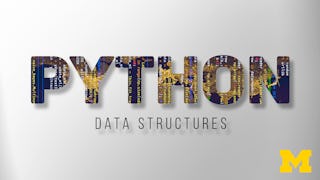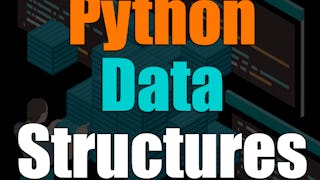This course provides an in-depth exploration of Python’s four built-in data structures: lists, tuples, sets, and dictionaries. Each structure will be introduced in detail, focusing on how to create, access, and manipulate them efficiently. The course will emphasize their unique characteristics and appropriate use cases. Learners will also apply their understanding in a case study, showcasing the practical application of these data structures to solve real-world problems.


您将学到什么
Evaluate the strengths and weaknesses of different Python data structures and apply them to solve practical problems
Implement various operations on Python data structures, such as accessing, slicing, modifying, and using comprehensions
Understand the characteristics and uses of core Python data structures, including lists, tuples, sets, and dictionaries.
要了解的详细信息

添加到您的领英档案
4 项作业
了解顶级公司的员工如何掌握热门技能

积累特定领域的专业知识
- 向行业专家学习新概念
- 获得对主题或工具的基础理解
- 通过实践项目培养工作相关技能
- 获得可共享的职业证书

该课程共有5个模块
This module introduces the list as a built-in data structure in Python. It covers the basics of what a list is, how to create lists, including heterogeneous lists (lists containing different data types), and how to access, slice, and manipulate them. Additionally, learners will explore list comprehension, a powerful Pythonic way to work efficiently with lists.
涵盖的内容
5篇阅读材料1个作业10个非评分实验室
This module explores the tuple, a built-in data structure in Python. It covers what a tuple is, how to create one, and how to work with heterogeneous tuples (containing elements of different types). Learners will learn how to access elements by index and through iteration, slice tuples, and understand the concept of tuple comprehension for efficient data handling.
涵盖的内容
2篇阅读材料1个作业6个非评分实验室
This module introduces the set, a built-in data structure in Python that stores unique, unordered elements. It covers what a set is, how to create one, and how to manage elements within a set. The module also explores set operations (such as union, intersection, and difference), common set methods, and set comprehension for efficient data manipulation.
涵盖的内容
2篇阅读材料1个作业5个非评分实验室
This module focuses on the dictionary (dict), a built-in Python data structure that stores key-value pairs. It covers what a dictionary is, how to create one, and how to access its elements using keys. Learners will explore common dictionary methods to manipulate data, and the module concludes with an introduction to dictionary comprehension for efficient data creation and processing.
涵盖的内容
2篇阅读材料1个作业4个非评分实验室
In this module, students will apply their knowledge of Python’s built-in data structures—list, tuple, set, and dictionary—by working on a real-life case study involving a grade book for students. They will use each of the data structures to store and manipulate the grade data, allowing them to practice and improve their understanding while comparing the advantages and limitations of each structure.
涵盖的内容
4个非评分实验室
获得职业证书
将此证书添加到您的 LinkedIn 个人资料、简历或履历中。在社交媒体和绩效考核中分享。
位教师

从 Data Analysis 浏览更多内容
 状态:免费试用
状态:免费试用University of Michigan
 状态:免费试用
状态:免费试用
人们为什么选择 Coursera 来帮助自己实现职业发展




常见问题
To access the course materials, assignments and to earn a Certificate, you will need to purchase the Certificate experience when you enroll in a course. You can try a Free Trial instead, or apply for Financial Aid. The course may offer 'Full Course, No Certificate' instead. This option lets you see all course materials, submit required assessments, and get a final grade. This also means that you will not be able to purchase a Certificate experience.
When you enroll in the course, you get access to all of the courses in the Specialization, and you earn a certificate when you complete the work. Your electronic Certificate will be added to your Accomplishments page - from there, you can print your Certificate or add it to your LinkedIn profile.
Yes. In select learning programs, you can apply for financial aid or a scholarship if you can’t afford the enrollment fee. If fin aid or scholarship is available for your learning program selection, you’ll find a link to apply on the description page.
更多问题
提供助学金,





